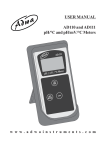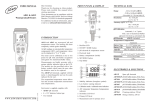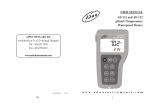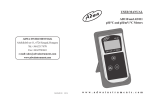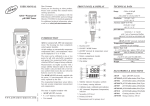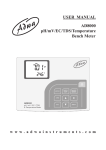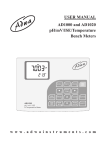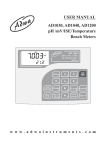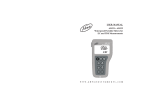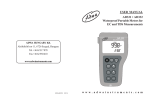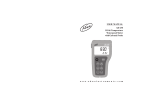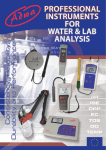Download USER MANUAL AD 130 pH/mV/Temperature Portable Meter
Transcript
USER MANUAL AD 130 pH/mV/Temperature Portable Meter w w w . a d w a i n s t r u m e n t s . c o m Dear Customer, Thank you for choosing an Adwa product. Please read carefully this manual before starting operations. This instrument is in compliance with the EMC directive 2004/108/EC and its standards, and Low Voltage Directive 2006/95/EC and its standards for electrical equipments. For additional technical information, please e-mail us at [email protected]. 2 TABLE OF CONTENTS Introduction ............................................................... 4 Technical Data .......................................................... 5 Front and Top Panels ................................................ 8 Operational Guide ................................................... 10 Hold and Memory Recall Functions ....................... 16 pH Calibration ......................................................... 17 Setup Menu ............................................................. 23 Battery Replacement .............................................. 25 LCD Message Guide .............................................. 27 pH Electrode Conditioning & Maintenance ............ 29 Electrodes, Probes and Solutions ............................ 31 Troubleshooting Guide ............................................. 32 Warranty ................................................................. 34 3 INTRODUCTION AD130 is a heavy-duty portable pH meter designed to provide laboratory results and accuracy even under harsh industrial conditions. Main features include: • 7 memorized buffers for pH calibration (pH 1.68, 4.01, 6.86, 7.01, 9.18, 10.01 and 12.45) • Messages on the LCD to make the calibration easy and accurate • pH readings with manual or automatic temperature compensation • pH calibration using pH buffers with 0.01 resolution • Temperature range from -20 to 120 °C (-4 to 248 °F) using AD7662 probe AD130 can also use ORP electrodes to measure mV, with a resolution up to 0.1 mV. 4 AD130 is supplied complete with: • AD1230B pH electrode with double ceramic junction, BNC connector and 1 m cable • AD7662 stainless steel temperature probe, 1 m cable • 1.5V AA alkaline batteries (4 pcs.) • User manual 5 TECHNICAL DATA Range -2.00 to 16.00 pH ±1999 mV -20.0 to 120.0 °C (-4.0 to 248.0 °F) Resolution 0.01 pH 0.1 mV (±699.9 mV) / 1 mV (outside) 0.1 °C (0.1 °F) Accuracy ±0.01 pH (@25 °C/77 °F) ±0.2 mV up to ±699.9 mV ±1 mV (outside) ±0.4 °C (±0.8 °F) (excluding probe error) pH Calibration 1 or 2 point calibration, 7 standard buffers available (pH 1.68, 4.01, 6.86, 7.01, 9.18, 10.01, 12.45) Temperature Manual or automatic, Compensation -20.0 to 120.0 °C (-4.0 to 248.0 °F) pH Electrode AD1230B Temperature Probe AD7662 Input Impedance 1012 Ohm Battery Type 4x1.5V AA size, alkaline Battery Life Approx. 500 hours of continuous use 6 Auto-off Environment Dimensions Weight User selectable: 20 minutes or disabled 0 to 50 °C (32 to 122 °F) RH max. 95% 188 x 96 x 70 mm 460 g 7 FRONT AND TOP PANELS 8 1. 2. 3. 4. Temperature probe socket Liquid Crystal Display (LCD) ON/OFF key, to turn the meter ON and OFF HOLD/CLR key, to freeze reading on display and store it in the instrument memory, or to clear calibration 5. CFM/SETUP key, to confirm calibration or enter setup mode 6. MRCL key, to recall stored value 7. Up & Down arrow keys, for manual temperature setting, entering menu parameters or changing buffer value 8. CAL key, to enter/exit calibration mode 9. RANGE key, to select pH or mV reading 10. Secondary display 11. Primary display 12. BNC connector for pH or ORP electrodes 9 OPERATIONAL GUIDE • The meter is supplied complete with four 1.5V AA alkaline batteries. Remove the cover, unwrap the batteries and install them while paying attention to their polarity (also see “Battery Replacement” section). • To prepare the instrument for use, connect pH electrode and temperature probe to the BNC and temperature sockets on the top of the instrument. • The temperature probe is used in conjunction with the pH electrode to utilize the meter’s ATC capability, but it can also be used independently to take temperature measurements. If the probe is disconnected, the temperature can be set manually using the arrow keys (see page 13 for details). 10 INSTRUMENT START-UP • Turn the instrument on by pressing ON/OFF. • At start-up the display shows all the used segments for a few seconds (or while the button is held), followed by the percentage indication of the remaining battery charge, then enters the measurement mode. • After measurement switch the meter off, clean the electrode and store it with a few drops of AD70300 storage solution in the tip protection bottle. • To save battery life, the auto-off feature turns the meter off after 20 minutes with no button pressed. This feature can also be disabled (see “Setup Menu” section for details). 11 pH MEASUREMENTS Remove the electrode tip protection bottle. Submerge the pH electrode tip (4 cm) and the temperature probe into the sample to be tested. If necessary, press the RANGE key until the display changes to the pH mode. Allow for the electrode to adjust and reading to stabilize (hourglass symbol turns off). The LCD will show the pH measurement together with the temperature of the sample. In order to take more accurate pH measurements, make .sure that the instrument is calibrated (see “pH Calibration” section for details). 12 It is recommended to keep the pH electrode always wet and to rinse it thoroughly with some sample to be measured before use. The pH reading is directly affected by temperature. In order to measure the pH accurately, temperature must be taken into consideration. If the sample temperature is different from the temperature at which the pH electrode was kept, allow a few minutes to reach thermal equilibrium. To use the meter’s automatic temperature compensation (ATC) capability, submerge the temperature probe into the sample as close to the electrode as possible and wait for a few minutes. If manual temperature compensation (MTC) is desired, the temperature probe must be disconnected. The display will show the default temperature of 25 °C or the last set temperature together with the °C (or °F) indicator blinking. 13 The MTC tag and up & down arrow symbols light up on the LCD to indicate that the meter is in MTC mode. The arrow keys can be used to enter the desired temperature value. Note: In MTC mode, the user can press and hold the arrow keys to incrementing or decrementing quickly the temperature value. The meter will keep measuring and the display is updated every second. ORP MEASUREMENTS To perform ORP measurements, connect the ORP electrode (AD3230B, optional) to the meter and turn it on by pressing the ON/OFF button. If necessary, enter the ORP mode by pressing RANGE until the display changes to mV. Submerge the ORP electrode tip (4 cm) into the sample to be tested and wait a few minutes for the reading to stabilize. Measurements within the ±699.9 mV range are displayed with 0.1 mV resolution, while outside this range the resolution automatically switches to 1 mV. 14 Since mV readings are not temperature compensated, the ATC and MTC tags are turned off . For accurate ORP measurements, the surface of the electrode must be clean and smooth. Pretreatment solutions are available to condition the electrode and improve its response time (see “Electrodes, Probes and Solutions” section for details). Notes: • When the reading is out of range, the closest full-scale value will blink on display. • If using pH electrode while in mV mode, the meter will measure the mV generated by the pH electrode. 15 HOLD AND MEMORY RECALL FUNCTIONS From measurement mode, pressing the HOLD key will freeze the reading on display. The frozen value is also stored in the instrument memory and can be recalled at any time by pressing the MRCL key. The H symbol blinks to indicate that the display is in hold mode. Press the HOLD key again to return to normal operations. Notes: • While in HOLD mode, the user can switch between pH and mV by pressing the RANGE key. • The memorized value is displayed as long as the MRCL key is pressed, together with H and RCL symbols. When the key is released, the display returns to normal measurement mode. 16 pH CALIBRATION It is recommended to calibrate the instrument frequently, especially if high accuracy is required. The pH range should be recalibrated: a) Whenever the pH electrode is replaced b) At least once a week c) After testing aggressive chemicals d) When extreme accuracy is required PREPARATION The user can choose among 7 memorized buffers (pH 1.68, 4.01, 6.86, 7.01, 9.18, 10.01 and 12.45). • Pour small quantities of selected buffer solutions into clean beakers. For accurate calibration use two beakers for each buffer solution, the first one for rinsing the electrode and the second one for calibration. • Remove the tip protection bottle and rinse the electrode with some of the buffer solution to be used for the first calibration point. 17 TWO-POINT CALIBRATION • Press the CAL key. CAL and BUFFER tags will be displayed. • The secondary LCD will display the value “7.01 pH”. • If a different calibration buffer is desired, use the arrow keys to change the displayed value. 18 • Submerge the electrode tip approximately 4 cm into the solution, place the temperature probe as close as possible to the electrode and stir gently. • The message NOT READY will blink for 12 seconds. Then, if the reading is not close to the selected buffer, WRONG BUFFER and WRONG ELECTRODE will blink alternatively; if the reading is close to the selected buffer, the calibration is performed and the display will show READY and blinking CFM. 19 • Press CFM to confirm the calibration and the meter will store the first calibration point. The primary LCD will show the calibrated reading, while the secondary LCD will show the second expected buffer (pH 4.01). • If a different calibration buffer is desired, select the appropriate value with the arrow keys. • After the first calibration point is confirmed, submerge the electrode tip approximately 4 cm into the second buffer solution, place the temperature probe as close as possible to the electrode and stir gently. • The LCD will flash NOT READY for 12 seconds. Then, if the reading is not close to the selected buffer, WRONG BUFFER and WRONG ELECTRODE will blink alternatively; if it is close to the selected buffer, the calibration is performed and the display will show READY and blinking CFM. 20 • Press the CFM key to confirm the second calibration point. • The meter stores the calibration data and returns to normal measurement mode. The tags corresponding to the buffers used for calibration will light up. 21 Notes: • To avoid erroneous procedures, the meter automatically skips the buffer used for the first calibration point. A difference of at least 1.5 pH units is required between the two buffers used for offset and slope calibration (i.e. once calibrated at either pH 7.01 or pH 6.86, the instrument automatically ignores the other value for the second point. Same for pH 10.01 and pH 9.18). • During calibration, the secondary LCD shows the selected buffer value. Press RANGE to display the buffer temperature. • To clear previous calibration and return to the default values, press the CLR key at any time after entering the calibration mode. The LCD will show the message “CLr CAL” for one second, and then will return to normal measurement mode. 22 ONE-POINT CALIBRATION For optimum accuracy it is always recommended to perform a two-point calibration, but for a faster operation it is also possible to carry out a single-point procedure. The meter can be calibrated using any of the memorized buffers, but the pH 7.01 or pH 6.86 value is normally the most appropriate for a single-point procedure. After calibrating the first point, press the CAL key to exit the calibration mode. SETUP MENU The instrument allows the user to configure the parameters through a setup menu. To enter the setup mode, from normal measurement mode press and hold the SETUP key for about 5 seconds. The value of each parameter can be changed by using the arrow keys and then confirmed with the CFM key. After setting and confirming a parameter, the meter will automatically show the next one. 23 This is the sequence of programmable parameters: 1. Auto-off feature: 20 minutes (default) or disabled. 2. Temperature measure unit: °C (default) or ° F. After setting the last parameter, pressing the CFM key will confirm the value and return to normal measurement mode. 24 BATTERY REPLACEMENT If batteries become weak, the display will flash the battery symbol to advise the user that approximately 25 hours of working time are left. It is recommended to replace the batteries soon. Moreover, when the battery level is too low to ensure reliable readings, the meter automatically turns off. At start-up the display will show “0 bAtt” for a few seconds and then the meter turns off. 25 Battery replacement must only take place in a safe area and using the battery type specified in this instruction manual. To replace rundown batteries, remove the battery cover and substitute all four 1.5V AA alkaline batteries with new ones, while paying attention to the correct polarity. Reattach and tighten the battery cover making sure that the gasket is in place. 26 LCD MESSAGE GUIDE MODE TAGS light up to indicate the corresponding active mode, and blink for warning the user. • SETUP on: setup menu mode has been entered • CFM blinking: ask confirmation of calibration point • CAL on: calibration mode has been entered • CAL blinking: meter is not calibrated or calibration is expired • H symbol blinking: reading is frozen on display and memorized • H symbol and RCL on: memorized value is displayed 27 TEMPERATURE COMPENSATION MODES: • MTC: manual compensation • ATC: automatic compensation BATTERY SYMBOL blinking: low battery condition. Batteries should be replaced soon. CALIBRATION MESSAGES: • NOT READY blinking: buffer has been recognized, but reading is not stable • READY on: buffer has been recognized and reading is stable • WRONG BUFFER and WRONG ELECTRODE blinking alternatively: wrong buffer and electrode not recognized 28 pH ELECTRODE CONDITIONING & MAINTENANCE PREPARATION PROCEDURE Remove the electrode tip protection bottle. DO NOT BE ALARMED IF SALT DEPOSITS ARE PRESENT. This is normal with electrodes and they will disappear when rinsed with water. During transport, tiny bubbles of air may form inside the glass bulb. The electrode cannot function properly under these conditions. These bubbles can be removed by shaking down the electrode as you would do with a glass thermometer. If the bulb and/or junction are dry, soak the electrode in AD70300 storage solution for at least one hour. STORAGE PROCEDURE To minimize clogging and ensure a quick response time, the glass bulb and the junction should always be kept moist. When not in use, store the electrode with AD70300 storage solution in the tip protection bottle. NEVER USE DISTILLED OR DEIONIZED WATER TO STORE THE ELECTRODE. 29 PERIODIC MAINTENANCE Inspect electrode and cable. The cable used for connection to the meter must be intact and there must be no points of broken insulation on the cable or cracks on the electrode stem or bulb. If any scratches or cracks are present, replace the electrode. Rinse off any salt deposits with water. Connectors must be perfectly clean and dry. CLEANING PROCEDURE Soak the electrode tip in AD7061 cleaning solution for approximately 30 minutes. IMPORTANT: After performing a cleaning procedure, rinse the electrode thoroughly with distilled water and soak it in AD70300 storage solution for at least 1 hour before taking measurements. 30 ELECTRODES, PROBES AND SOLUTIONS AD1230B AD3230B AD7662 AD70004P AD7004 AD70007P AD7007 AD70010P AD7010 AD70300 AD7061 pH electrode with double ceramic junction, BNC connector and 1 m cable ORP electrode with single ceramic junction, BNC connector and 1 m cable Stainless steel temperature probe with 1 m cable. pH 4.01 buffer solution, 20 ml sachet, 25 pcs. pH 4.01 buffer solution, 230 ml bottle pH 7.01 buffer solution, 20 ml sachet, 25 pcs. pH 7.01 buffer solution, 230 ml bottle pH 10.01 buffer solution, 20 ml sachet, 25 pcs. pH 10.01 buffer solution, 230 ml bottle Electrode storage solution, 230 ml bottle Electrode cleaning solution, 230 ml bottle 31 TROUBLESHOOTING GUIDE SOLUTION SYMPTOM PROBLEM Soak the electrode Slow response/ Dirty pH electrode. tip in AD 7061cleanexcessive drift. ing solution for 30 minutes and then follow the storage procedure. Clean the electrode. Reading Clogged/dirty fluctuate up and junction. down (noise). Check that sample is within measurable range. Check electrolyte level and general electrode status. Soak electrode in mV scale out Dry membrane or AD70300 storage of range. dry junction. solution for at least 30 minutes. Display shows Temperature probe Connect or replace blinking °C or °F. is not connected or temperature probe. out of order. The display Reading out of shows blinking range. full scale value. 32 SYMPTOM Display shows blinking battery symbol. Meter does not work with temperature probe. Meter fails to calibrate or gives faulty readings. "WRONG CAL" is displayed during pH calibration procedure. Meter shuts off. "Er0, Er1, Er2" message at start up. "Clr" message at start up. PROBLEM Low battery level. SOLUTION Change batteries. Replace the Broken temperature probe. temperature probe. Broken pH electrode. Replace electrode. Wrong or contaminated buffer. Check that buffer solution is correct and fresh. Dead batteries or Change batteries auto-off feature is or press ON/OFF. enable (in this case, meter shuts off after 20 minutes of non-use). Contact your EEPROM error. dealer or any Adwa service center. Loaded default pH Perform pH calibration values. calibration. 33 WARRANTY Adwa warrants this product to be free of defects in material and workmanship as stated in the operating manual. If repair or adjustment is necessary and has not been the result of abuse, misuse or improper handling within the warranty period, please contact your dealer or the nearest Adwa Office for the RGA (Return Goods Authorization) number to put on the outside of your package. Warranted service will be made without charge. The meter is warranted for a period of 2 years, while probes are warranted for 6 months. The warranty period commences from the original date of sale. Warranty is only valid when the product is used under normal conditions and in accordance with the instruction manual. The warranty is void if the instrument is repaired or serviced by unauthorized personnel, not used in accordance to the instructions, or if non-Adwa accessories such as buffer solutions, probes, etc. are used in conjunction with the meter. Adwa will not be held responsible for any accident whether directly or indirectly, caused by the use of this instrument. 34 35 ADWA HUNGARY Kft. Alsókikötõ sor 11, 6726 Szeged, Hungary Tel. +36 62 317 878 Fax +36 62 550 610 www.adwainstruments.com MANAD130 09/14




































